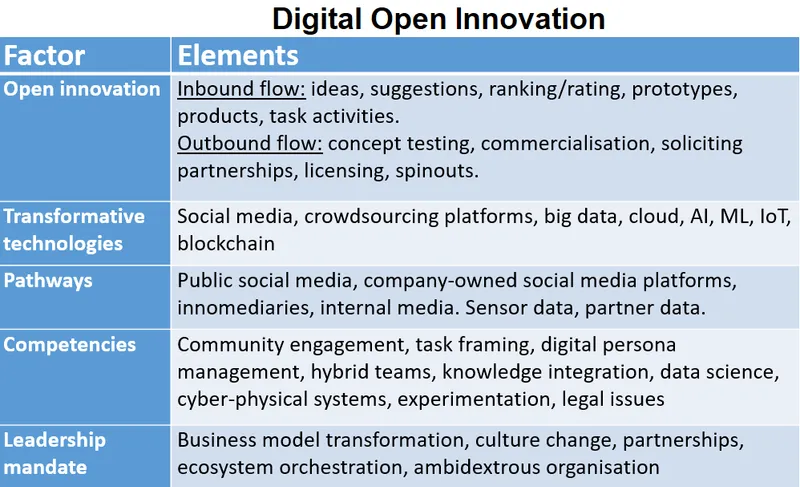Launched in 2012, YourStory’s Book Review section features over 290 titles on creativity, innovation, entrepreneurship, and digital transformation. See also our related columns The Turning Point, Techie Tuesdays, and Storybites.
Though frameworks and examples of open innovation have been around for a few decades, digital technologies are accelerating them like never before. Insights and tips in this regard are well-presented in the book Managing Digital Open Innovation, edited by Pierre-Jean Barlatier and Anne-Laure Mention.
Pierre-Jean Barlatier is Associate Professor of Strategy at EDHEC Business School in France, while Anne-Laure Mention is the Director of the Global Business Innovation Enabling Capability Platform at RMIT, Australia. She is one of the founding editors of the Journal of Innovation Management.
The book has chapters contributed by around 50 authors. Thoroughly referenced and written in an academic style, its findings will be useful for corporate innovators and aspiring entrepreneurs as well.
Here are my key takeaways from the 19 chapters in this hefty 580-page book, summarised as well in the table below. See also my reviews of the related books: Innovation Ultimatum, Seeing Digital, The Invincible Company, Customer Innovation, The AI Advantage, Dual Transformation, Open Data Now, and The Serendipity Mindset.

(Image credit: YourStory)
Foundations
Open innovation is defined by Henry Chesbrough as “the use of purposive inflows and outflows of knowledge to accelerate internal innovation, and expand the markets for external use of innovation, respectively.”
Today, many innovation processes are being enabled and transformed by digital technologies such as social media, crowdsourcing platforms, big data, cloud, AI, ML, IoT, and blockchain. This transformation is happening at the B2C and B2B levels, as well as within enterprises, SMEs, and startups.
The editors chart out these impacts in the three phases of innovation: define, design and validate, across inward and outward flows. Inbound contributions include ideas, suggestions, ranking/rating, prototypes, products, and task activities. Outbound activities include concept testing, soliciting partnerships, licensing, and spinouts.
Successive waves of digital innovation are layering and converging, unleashing a cascade of combinatorial innovations.
Organisations can effectively harness digital open innovation to accelerate experimenting, testing, and learning processes. Digital components such as platforms and smartphones have become key parts (not just enablers) of business models of companies like Apple and Google, according to Dagfinn Wage and Gunnar Crawford.
Trends to watch include the possible use of blockchain in open innovation for record-keeping, smart contracts, patent enforcement, and payments.
Examples of digitally-enabled innovation
The book is packed with examples of how digital is transforming innovation, not just by nimble savvy startups or the GAFA tech giants. For example, big data is used by AT&T (to resolve situations) and Bism@rt (fraud detection in public transportation).
A range of crowdsourcing platforms has emerged, such as Threadless (T-shirt design), Clickworker (micro-tasks), CrowdFlower (transcription), MuckenAtlas (monitoring mosquitoes), TestBirds (software testing), Jovoto (creative works contest), SAPien (innovation contests), and BeeUP (business solutions by professors and students).
Large firms using crowdsourcing include Dell (customer suggestions for product improvement), GE (Ecoimagination, with 5,000 ideas from 60,000 customers), and Fiat.
AI and ML are used by Boxever (engaging with travelling customers) and Amazon (predictive demand forecasting); they can speed up prototyping as well. Cloud computing is used by IBM (to identify drug imitation practices) and other firms for business agility, global collaboration, and reducing time to market.
IoT is used by Haier (managing production processes), and Tesla (connected cars). Blockchain is being used by Maersk (connecting supply chain partners) and TradeShift (invoice payments). Corporate websites and social media are leveraged by Cisco (iPrize competition for new business ideas) and Lego (new designs, improvements).
Product companies leveraging digital to offer smart services (“servitisation”) include BOGE (efficiency analysis for compressors), GEA (condition monitoring in food processing), and ThyssenKrupp (predictive maintenance for elevators).

Social media
For open innovators, social media have emerged as a “global brain,” providing speed, interactivity, diversity, flexibility, and reach. This helps companies source ideas, understand markets, monitor customer opinion, ideate on new concepts, test offerings, and market new products.
Digital media in the context of open innovation are of four types: public social media (eg. Twitter), company-owned social media platforms (eg. MyStarbucksIdea, EMC Community), innomediaries (eg. Innocentive, NineSigma, OneBillionMinds), and internal media (eg. licensed from Yammer).
Types of network orchestrators in such settings include central (strategic), medial (contributing) and peripheral, according to Angela Bacchetta Beckh, Mathias Beck and Patrick-Yves Badillo. They show how three theory areas intersect here: personal behaviour, social behaviour, and mass communication, eg. risk perception, technology adoption, social network analysis, and media richness.
User communities can be involved as co-designers and co-developers, according to Sharan Kaur Garib Singh. Social media can be leveraged for idea generation as well as promotion and commercialisation. They are good sources of lead users as well.
Unfortunately, many corporate managers are sceptical about the potential of social media for innovation. Employee training is needed in areas like digital persona management and community engagement; third party consultants can be engaged in this regard. An internal culture of creativity and empowerment should be nurtured.
Crowdsourcing
Crowds offer creativity, expertise and skills. Crowdsourcing platforms can source a large number of diverse ideas from the online community, thus reducing failure risk via features for testing, ranking, rating, voting, and validation.
In some cases, separate crowds can be used for idea generation and idea selection. Ideas sourced from crowds can be used for improvements, incremental innovations and even radical leaps; such ideas can be sourced occasionally or continuously.
Crowd insights influence production choices and volumes, and mutual value can be generated by co-creation platforms. Crowdsourcing can also help companies detect weak signals at the fringe.
However, there can be a backlash if contributors or “user innovators” don’t get feedback about how their ideas are being rated or used, Thierry Burger-Helmchen and Erica Siegel caution. “A crowd is not a gigantic, peaceful blue ocean of contributors. It is a fast river that needs constant monitoring,” they evocatively describe.
They classify crowdsourcing models into several types: micro-tasking (eg. picture identification), broadcast search (product rating), reciprocal collaboration (Threadless), and competitions (eg. Netflix algorithm challenge).
Effectively harnessing crowdsourcing calls for skills and competencies in framing the task that needs to be solved, combining manual and automated rating systems, devising incentives, handling legal issues, ecosystem alignment, workflow design, and overall strategy and governance.
Crowdsourcing can be a complex activity with a number of unpredictable emergent phenomena, the authors caution. Crowds, corporate experts and broader internal communities need to collaborate in this regard.

Big data
Big data helps companies generate value from real-time information, such as discover customer need, and deliver customised offerings. However, care must be taken to address data quality, availability, relevance, consistency, timeliness, currency, and ownership issues.
“Data is now recognised as a powerful source of innovation,” according to Tuija Rentala, Katariina Palomaki and Katri Valkokari. This applies to B2C and B2B contexts, eg. operational efficiency and decision-making.
In addition to data quality challenges, there are also issues at the level of processing (eg. finding correlations), operations (eg. visualisation), and management (eg. privacy, governance). Business models and organisational culture will need to be transformed for process renewal and strategy change. It is important to “expand the way of thinking.”
Industry clusters
Digital ecosystems affect industries and countries in different ways. Vicky Long shows how the rise of digital distribution, smartphones and gamer communities has transformed the videogames industry in Sweden from a linear value chain to a networked value web.
Examples include the “mod” (modification) culture, where gamers modify game elements. Collective creativity combines with top-down digital determinism in this regard. Video games are a combination of audio-visual artworks and code, and open the door to “cross inspiration” from other media like books, films and music.
Innovations to watch here include indie gaming, in-game purchasing and advertising, mobile gaming, and cross-platform games and alliances.
Another study on German mechanical engineering SMEs examines the use of digital for smart products, operations, factories, and services. Boundaries between traditional mechanical engineering and IT are shifting, and some firms are spinning off IT companies to attract better talent.
Intercultural communication and interdisciplinary collaboration are increasing. Emerging trends are modular development, user-centric design, and data security competencies.
Another case study focuses on professional services consultancy. Its teams leveraged LinkedIn for new service development via online interactions, cultivating contacts, sharing content, tracking trends, and drawing inspiration.
From science to open science
The practice of science has been digitally transformed thanks to online publishing, micro-content, automated data collection, networked collaboration, data-sharing platforms, simulation models, open practices, visualisation tools, and ML.
Citizen science involves citizens in data collection (eg. SETI), Eric Prem explains. New fields have emerged, such as bioinformatics and astro-informatics.
Trends to watch include the rise of VR and 3D printing. From a knowledge management (KM) framework, digital media have helped externalisation of knowledge.
Management challenges
While the above capabilities and achievements look impressive, harnessing digital innovation calls for effective network orchestration and open-minded culture.
Incumbent companies and even entire industries have been disrupted by digital players, such as the music industry. Many large firms and SMEs find it challenging to transition their business models for digital open innovation; just having digital skills is not enough.
The authors show that businesses must be adept in forming industry alliances, devising flexible strategies, and continually developing competencies. They must be willing to experiment, learn by doing, and bounce back from failure.
Human resistance to change, technological inertia, core rigidities and regulatory requirements are tough challenges in sectors like banking, observe Clarice Bertin and Veronique Schaeffer. They face formidable competition from digital-savvy fintechs and the GAFA giants, and need to upgrade strategies and skills to meet the new expectations of customers.
“Like other organisations, banks have to become ambidextrous,” the authors advise, to build new capabilities alongside legacy businesses. They recommend creativity development, internal ideas contests, a knowledge-sharing culture, and an internal incubator as some measures for digital innovation.
Engaging with startups via external accelerators is another option. Some banks have set up their own accelerators as well (see YourStory’s Startup Hatch section for accelerator and incubator profiles).
It’s not just getting and sorting external ideas that can be a challenge, but the absorptive capacity to integrate this new knowledge. Sensemaking, interpretation, and synthesis for decision-making are key next steps.
Creation of new value involves assimilation and transformation of crowdsourced knowledge, according to Emilie Ruiz, Sebastien Brion, and Guy Parmentier.
Challenges that come in the way include ‘not invented here’ syndrome, lack of interest in or use of repositories of crowd knowledge, separation of crowd and core teams, dismissal of the quality of ideas from “Sunday inventors” as compared to internal experts, and even perceptions of the crowd as a competitor.

Future research
The book presents extensive research on digital open innovation by mostly European businesses, and opens the door to further research in other parts of the world and other sectors like government and civil society. Examples include hackathons for developing new platforms and policies, and launching of open data sets by government agencies.
Other topics to explore deeper are how to creatively frame problem questions in open calls, the differentiation factors of new innomediaries, and the transformation of players in ‘physical’ open innovation like makerspaces.
More research can develop maturity curves for companies embarking on open innovation journeys, eg. low-data, data-enhanced, and data-driven business models, as shown by Romy Hilbig, Stefanie Hecht, and Bennet Etsiwah.
For innovation practitioners, perhaps a new tool like Open Innovation Canvas can be devised, like the Business Model Canvas or YourStory’s Changemaker Story Canvas.
The road ahead
The contributors in the book showcase several research methods to study digital open innovation: surveys, semi-structured interviews, exploratory interviews, semi-directive interviews, industry reports, and “snowballing” of references and citations. Perhaps some newer methods will use blockchain to preserve the integrity and trust of the research steps.
In sum, the book provides a valuable single-volume insight into digital open innovation and how it contributes to value creation, delivery, and capture. In the long run, companies will need to master the creation of cyber-physical systems, product families, and business model portfolios.
This has important implications at the level of strategy, tactics and operations. Leaders will have to show the way to becoming an ambidextrous organisation, and cultivate new strategic partnerships in this regard. Analysis at the macro-, meso- and micro-levels will be valuable as well.
Leadership push, market pull, competitive positioning, and tech opportunity mapping hold the key to harnessing the next waves of digital open innovation.
YourStory has also published the pocketbook ‘Proverbs and Quotes for Entrepreneurs: A World of Inspiration for Startups’ as a creative and motivational guide for innovators (downloadable as apps here: Apple, Android).










